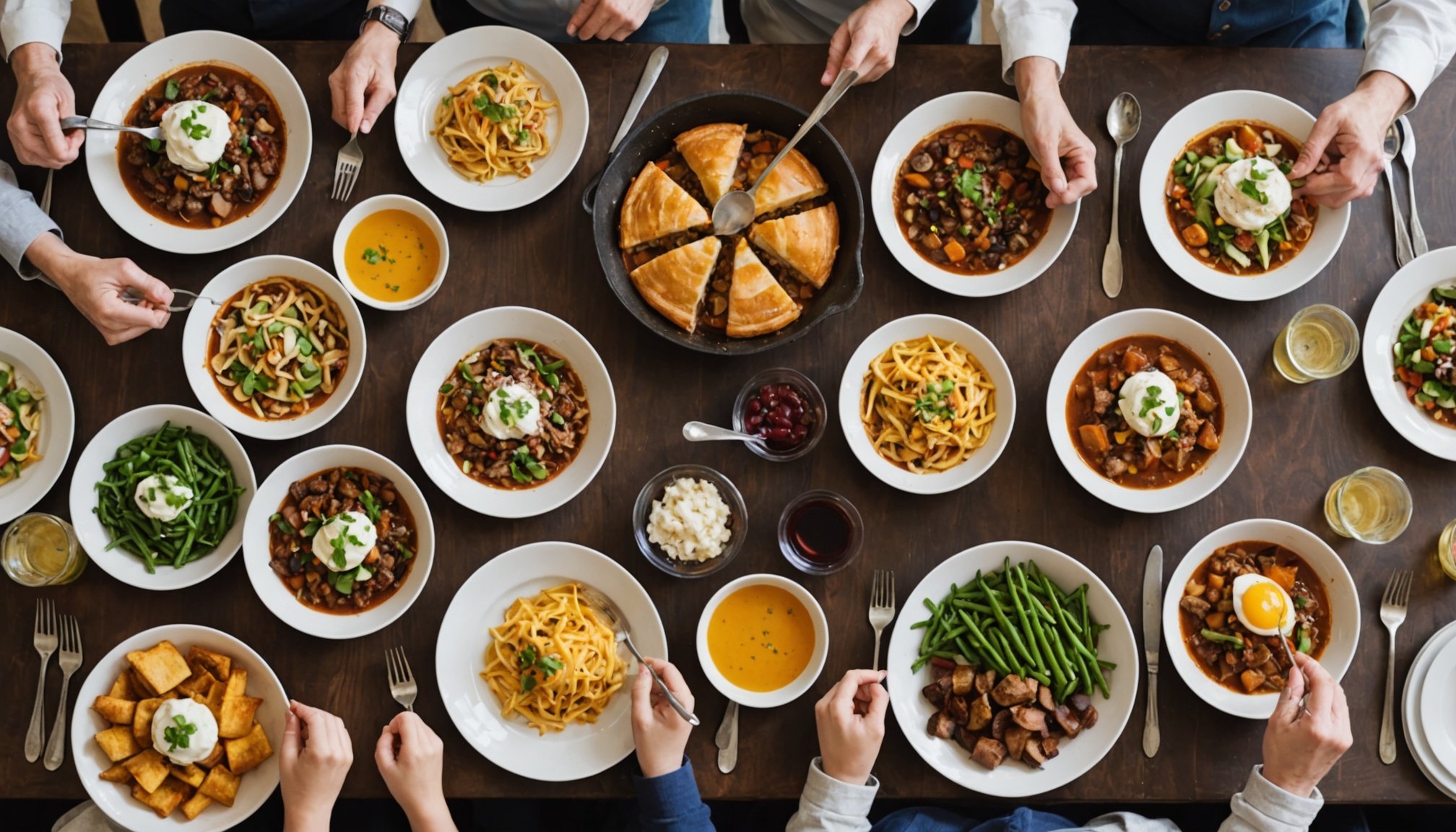Overview of Family-Friendly Menu Concepts
Designing a Family-Friendly Menu requires catering to diverse palates across age groups. This means combining elements that capture the imagination and taste buds of both children and adults. Family gatherings thrive on inclusivity, with menu ideas that are both appealing and practical.
Balancing flavors is crucial. Dishes should entice kids with familiar tastes while offering complexities that adults savour. For instance, offering a spicy option alongside a mild version can please everyone. Themes play a pivotal role, too—consider a picnic-style setup with finger foods, or a ‘build-your-own’ taco night, fostering creativity and engagement.
Also to see : Creating a Robust Health and Safety Blueprint for Your Commercial Kitchen: Essential Steps Unveiled
Including interactive dishes, where kids assemble their portions, can enhance the dining experience. Moreover, opting for meals with shared components encourages bonding and conversation. Ultimately, the goal is to create a menu that acknowledges children’s need for fun and adults’ desire for refined flavors, ensuring every family member departs satisfied and happy.
Kid-Friendly Recipes
Creating kid-friendly recipes is about more than just taste; it’s about crafting culinary experiences that engage and delight children. Embedding fun and interactivity into meals is essential. By designing dishes children can help prepare, you foster excitement and participation. Think of assembling pizza using pre-cut ingredients, where kids can choose their toppings, as a practical and enjoyable option. This approach not only makes mealtime engaging but helps develop their appreciation for cooking.
In the same genre : Top Tips to Keep Your Restaurant’s Raw Bar Fresh and Irresistible
Healthy snacks for kids also play a vital role in a family menu. Focus on incorporating nutrient-rich ingredients in a way that feels disguised as gaming. For example, vegetable sticks paired with colourful, flavourful dips can make even the pickiest eaters intrigued by healthy options.
Moving to creative main dishes, simplicity yet innovation is key. Imagine transforming traditional spaghetti with veggie-filled meatballs or playful presentation ideas like pancakes shaped as animals or faces. These small tweaks can make meals not only appetising but educational. Encouraging children to explore various flavours and textures lays the foundation for a lifelong positive relationship with food.
Adult-Approved Dishes
Crafting dishes that resonate with adults requires attention to sophistication and indulgence. A Family-Friendly Menu benefits from integrating Adult Meal Favorites that complement kid-friendly choices. Offering flavourful options like grilled herb-infused chicken or spicy shrimp stir-fry keeps adults intrigued and satisfied. These dishes can be paired with milder options to cater to children’s tastes while adding depth for the grown-ups.
Incorporating gourmet ingredients elevates the overall dining experience without complicating preparations. Consider using sundried tomatoes, truffle oil, or artisanal cheeses. The key is to maintain simplicity while enhancing flavour profiles. This can be achieved by focusing on quality and seasoning, ensuring each bite is an exploration of taste.
Balancing these sophisticated flavours with nutritional value encourages adults to savour while making health-conscious choices. Adults often appreciate diverse textures and aromas, so incorporating elements like crunch or zest can elevate a meal’s appeal. Highlighting these aspects can ensure every family member finds something they relish, bridging the gap between diverse taste preferences in a family setting without overwhelming the menu with complexity.
Balancing Nutrition and Flavor
Creating Healthy Family Meals is an art that involves blending nutrition with flavor in a way that appeals to all family members. To achieve this, consider these strategies:
Tips for Nutritious Cooking
Opt for fresh and seasonal ingredients, which ensure optimal flavor and nutritional content. For example, replace refined grains with whole grains in recipes to boost fibre intake.
Creative Substitutions
Enhancing dishes with simple swaps can significantly increase their healthiness without sacrificing taste. Try substituting Greek yogurt for sour cream or using avocado in place of mayonnaise for extra healthy fats.
Caloric Awareness
Understanding serving sizes for various age groups ensures that meals are appropriately portioned. Tailor your dishes so that adults and older children receive servings suited to their dietary needs while smaller portions cater to younger kids.
Incorporating these elements not only garners more nutrient-dense meals but also ensures that the menu remains vibrant and flavorful. By focusing on these aspects, families can enjoy meals that cater to both their health requirements and their taste preferences, making healthy eating an enjoyable part of family life.
Accommodating Dietary Restrictions
When designing a Family-Friendly Menu, accommodating dietary restrictions is paramount to ensuring everyone can participate in meals. Common restrictions include gluten-free, nut-free, and vegetarian options, each requiring mindful preparation and creativity in meal planning. Strive to offer Dietary-Friendly Dishes that don’t compromise taste or inclusivity.
Meal Planning Tips
Incorporate alternatives like gluten-free grains or plant-based proteins to diversify options effortlessly. Experimenting with quinoa or lentils, for example, can provide satisfying replacements for those avoiding wheat or meat.
Resourceful Use of Allergens
Being attentive to allergens is essential. Implement strategies such as separating preparation areas or labelling dishes, allowing for safe dining experiences.
Inclusive Menus
Creating an inclusive menu means recognising overlapping dietary needs and preferences. Offering a variety of dishes—like a hearty vegetable stew or a vibrant salad bar—can cater to multiple restrictions simultaneously. With thoughtful planning, designing meals that cater to diverse dietary requirements becomes less daunting and more rewarding for family gatherings. Ultimately, fostering an enjoyable environment comes down to embracing creativity and ensuring no family member feels excluded from the dining experience.
Visual Appeal of the Menu
Creating a visually appealing menu is essential for engaging diners of all ages. Menu Presentation elevates the dining experience by making dishes more inviting and enticing. Incorporating plating techniques is a great way to add a professional touch. Consider arranging food thoughtfully, using items such as sauces or herbs to frame each plate artistically.
The use of colourful ingredients enhances aesthetic appeal while delivering nutritional value. Fresh herbs, vibrant fruits, and vegetables not only add to the visual charm but also boost the meal’s flavour profile. This can be particularly appealing to children, as colourful dishes are more likely to capture their interest.
Creating a cohesive aesthetic for a family feast can be achieved through a festive table layout. Thoughtful arrangements featuring a range of textures and colours transform a meal into a memorable experience. By paying attention to these details, crafting a family-friendly table setting woven with creativity and care becomes simple. This approach not only makes meals more visually enticing but heightens the overall enjoyment and love for family dining.
Meal Preparation and Cooking Time Estimates
Creating a Family-Friendly Menu not only involves exciting flavours but also efficient Cooking Time Management. Efficiently preparing meals saves time while maintaining quality, creating a seamless dining experience for families.
Strategies for Efficient Meal Prep
Focus on combining tasks. For instance, while ingredients for a main dish simmer, chop vegetables for the next meal. This synchronisation minimises time spent in the kitchen. Preparing ingredients in advance, like pre-cutting vegetables or marinating proteins, streamlines the cooking process.
Tips for Involving Kids
Incorporate age-appropriate tasks. Younger children can wash vegetables or mix ingredients, while older kids might tackle more complex tasks, like peeling or stirring. Engaging them gives them a sense of responsibility and excitement.
Saving Time
Batch cooking certain components, like grains or sauces, allows for flexibility in weekly meals. Prepare double batches to use in multiple dishes, reducing overall time spent cooking.
Establishing these practices ensures that family mealtime remains enjoyable and relaxed, with less stress for the cook. This approach fosters a love for cooking while efficiently managing time and resources.
Final Touches and Serving Suggestions
Enhancing the Family Dining Experience involves thoughtful finishing touches and serving methods that welcome diners of all ages. Creating an inviting atmosphere sets the tone for memorable meals. Simple additions like themed table settings or mood lighting can transform dining moments into family traditions.
Creating a Family-Friendly Atmosphere
A family-friendly environment fosters connection and engagement. Incorporating personalised placemats or rotating family responsibilities, like setting the table, can make each meal feel special. Incorporating these elements encourages everyone to feel involved and valued.
Serving Techniques for Ease
Efficient serving begins with adjusting portion sizes and styles to cater to diverse age groups. Offering dishes in a family-style format allows individuals to customise their servings, creating a relaxed and interactive dining experience. This practice encourages sharing and discovery at the table.
Catering to Different Palates
Adapting meals to meet varied tastes is key. Allow family members to contribute their favourite dishes or flavours, making meals more inclusive and enjoyable. Emphasising balanced options and showcasing a range of tastes ensures everyone leaves the table satisfied. Embracing diverse flavours and preferences during the serving process enhances family meal enjoyment.






